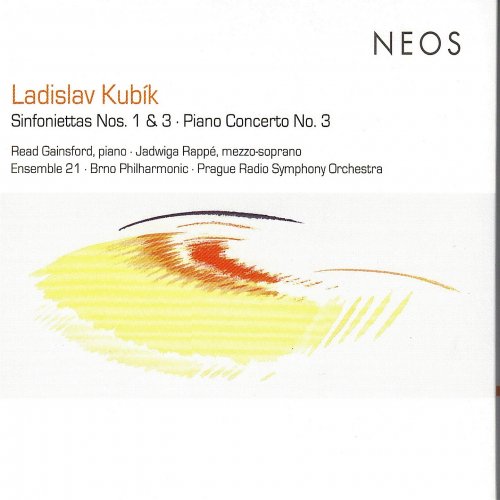
Read Gainsford, Ensemble 21, Brno Philharmonic, Prague Radio Symphony Orchestra - Kubik: Sinfoniettas Nos. 1 & 3 & Piano Concerto No. 3 (2011)
BAND/ARTIST: Read Gainsford, Ensemble 21, Brno Philharmonic, Prague Radio Symphony Orchestra
- Title: Kubik: Sinfoniettas Nos. 1 & 3 & Piano Concerto No. 3
- Year Of Release: 2011
- Label: Neos
- Genre: Classical
- Quality: FLAC (tracks)
- Total Time: 45:55
- Total Size: 191 Mb
- WebSite: Album Preview
Tracklist:
Sinfonietta No. 1 (Ensemble 21, Jakub Hrusa)
01. Sinfonietta No. 1 - 00:09:41
Concerto No. 3 (Read Gainsford)
02. I. Maestoso - Aggressivo - Appassionato - Lirico - Piu Agitato - Drammatico - Maestoso - 00:04:52
03. II. Molto Sostenuto - Con Fluidezza - Calmando - 00:07:50
04. III. Presto - Tempo rigoroso - Meno mosso - Presto - Frenetico - L'istesso tempo - Epilogue - Lento - 00:08:04
Sinfonietta No. 3 'gong' (Prague Symphony Orchestra)
05. I. Introductory Movement - 00:03:42
06. II. Gong - 00:05:42
07. III. 'ein Gott Vermags...' - 00:06:04
Performers:
Read Gainsford (piano), Jadwiga Rappe (mezzo-soprano)
Ensemble 21, Brno Philharmonic, Prague Radio Symphony Orchestra, Kuhn Mixed Choir, Jakub Hrusa, Alexander Jimenez, Jan Kucera
Sinfonietta No. 1 (Ensemble 21, Jakub Hrusa)
01. Sinfonietta No. 1 - 00:09:41
Concerto No. 3 (Read Gainsford)
02. I. Maestoso - Aggressivo - Appassionato - Lirico - Piu Agitato - Drammatico - Maestoso - 00:04:52
03. II. Molto Sostenuto - Con Fluidezza - Calmando - 00:07:50
04. III. Presto - Tempo rigoroso - Meno mosso - Presto - Frenetico - L'istesso tempo - Epilogue - Lento - 00:08:04
Sinfonietta No. 3 'gong' (Prague Symphony Orchestra)
05. I. Introductory Movement - 00:03:42
06. II. Gong - 00:05:42
07. III. 'ein Gott Vermags...' - 00:06:04
Performers:
Read Gainsford (piano), Jadwiga Rappe (mezzo-soprano)
Ensemble 21, Brno Philharmonic, Prague Radio Symphony Orchestra, Kuhn Mixed Choir, Jakub Hrusa, Alexander Jimenez, Jan Kucera
The basic musical language of these three pieces by Czech-American composer Ladislav Kubik draws on atonality and other facets of Central European modernism. But each of the three works combines that basic language with imaginative ideas that have appealed to audiences even in the conservative U.S. Southeast, where Kubik has taught for some years at Florida State University. Kubik seems to have the knack of conducting rigorous formal experiments in a crowd-pleasing way. The Sinfonietta No. 1 (1998), despite its name and its large ensemble, is a true chamber work; each of its 19 instruments has a basically soloistic part and makes a discrete contribution to the whole. Annotator Michael Buchler contends that Kubik "draws influence ... from his own Slavic heritage," but that is in evidence here only (and only indirectly) in the Concerto No. 3 for piano, orchestra, and electronics, which is dedicated to the memory of Bohuslav Martinu and quotes his music in its second and third movements. The role of the electronics is not large in either this work or the Sinfonietta No. 3. In the concerto it slightly modifies the Martinu quotations, giving them a ghostly quality. This might well work better in live performance (and this may well be the only classical work for which surround sound in the auditorium is suggested), but the idea is interesting in itself. The Sinfonietta No. 3 for mezzo soprano, mixed choir, orchestra, and electronics ("Gong") involves quite subtle settings of a pair of poems by Rainer Maria Rilke, perhaps the black belt for composers undertaking renderings of German poetry. All three of these works here receive their world premieres, in performances from three different Czech ensembles with three different conductors. All the players, however, are stimulated to committed performances, and they are backed by clear engineering from Germany's NEOS label.
As a ISRA.CLOUD's PREMIUM member you will have the following benefits:
- Unlimited high speed downloads
- Download directly without waiting time
- Unlimited parallel downloads
- Support for download accelerators
- No advertising
- Resume broken downloads


